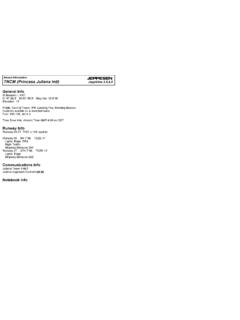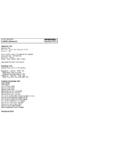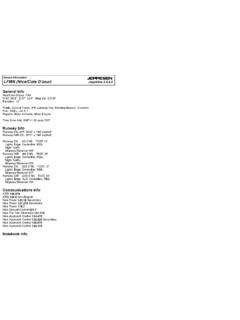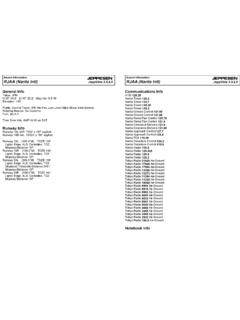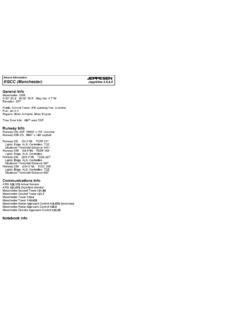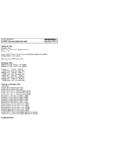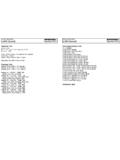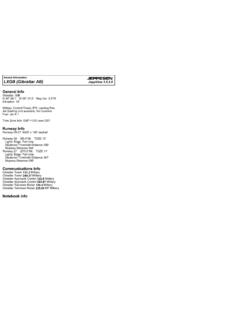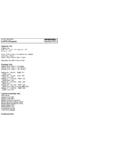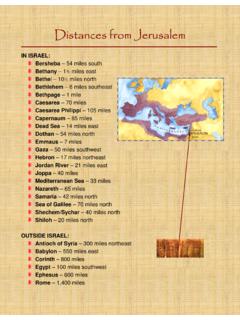Transcription of JEPPESEN VHHH (Hong Kong Intl) - FlySea
1 JEPPESENJEPPESENJEPPESENJEPPESENJeppView ( hong kong Intl) Airport InformationGeneral InfoHong kong , HKGN 22 ' E113 ' Mag Var: WElevation: 28'Public, Control Tower, IFR, No Fee, Low Level Wind Shear Alert System,CustomsFuel: 100-130, Jet A-1 Repairs: Major Airframe, Major EngineTime Zone Info: GMT+8:00 no DSTR unway InfoRunway 07L-25R 12467' x 197' asphaltRunway 07R-25L 12467' x 197' asphaltRunway 07L ( M) TDZE 22' Lights: Edge, ALS, Centerline, TDZ Displaced Threshold Distance 568'Runway 07R ( M) TDZE 27' Lights: Edge, ALS, Centerline, TDZ Displaced Threshold Distance 525'Runway 25L ( M) TDZE 27' Lights: Edge, ALS, Centerline, TDZR unway 25R ( M) TDZE 22' Lights: Edge, ALS, Centerline, TDZ Displaced Threshold Distance 571'JEPPESENJEPPESENJEPPESENJEPPESENJepp View ( hong kong Intl) Airport InformationCommunications InfoATIS Arrival ServiceATIS Departure ServiceHong kong Tower South Tower kong Tower north Tower SecondaryHong kong Tower north Tower kong Ground South Ground Control kong Ground north Ground Control kong Delivery Clearance Delivery kong Delivery Clearance Delivery SecondaryHong kong Precision Approach Control kong Director Approach Control kong Director Approach Control kong Director Approach Control SecondaryHong kong Approach Control kong Departure Control kong Departure Control SecondaryHong kong Departure Control kong Departure Radar Control InfoLicensed to max.
2 Printed on 16 Feb : PRINTED FROM AN EXPIRED REVISION. Disc 01-2008 JEPPESENJeppView | JEPPESEN SANDERSON, INC., 2006. ALL RIGHTS kong , PR OF CHINAVHHH/HKGHONG kong INTLJEPPESEN+ ATISD-ATIS NOISE ABATEMENT NOISE MITIGATING MEASURESThe following procedures are implemented daily to reduce ACFT noise levels, when operating conditions permit. Noise mitigating procedures are not applicable to calibration PREFERENTIAL USE OF RWYS 07L/RAs a noise mitigating measure between 0001-0700LT, RWYs 07L/R will be nominated as the RWY direction-in-use whenever the tailwind component (including gusts) is 10 KT or less when the RWY is dry, or 5 KT or less when the RWY is not dry. During this period RWYs 25L/R may be used if operationally required, unserviceability of navigation aids, adverse weather conditions, ACFT performance, traffic situations RUN-UP TESTSE ngine run-ups are subject to the following conditions.
3 - An engine ground run is defined as any engine start-up not associated with a planned ACFT Engine ground runs at ground idle power of not more than two engines at a time and for a duration not exceeding ten minutes may be carried out on the Passenger Apron or Cargo Engine runs above ground idle power shall be carried out in the run-up facility and engine ground runs at idle power for a duration in excess of ten minutes shall only be carried out in approved All engine ground runs must be fully supervised by ground Maintenance or test running of jet engines not mounted on an ACFT is prohibited unless performed in a test cell of adequate GROUND RUN PROCEDURESI nitial request for a ground engine run should be made to the APT Authority Apron Control Centre (Tel No: 2910 1112). The airline, ACFT maintenance agent engineer or mechanic in charge of the engine test is responsible for ensuring that all safety precautions against injury to persons or damage to properties, aircraft, vehicles and equipment in the vicinity are ready to conduct the engine run, the pilot or authorized engineer shall obtain start-up clearance from Apron Control on and a listening watch shall be maintained on the frequency throughout the engine run.
4 The ACFT anti-collision beacons must be activated for the entire duration of the ground engine run and Apron Control should be advised on its completion. The ground crew in charge must maintain communication with cockpit personnel and be able to stop the engine run immediately if JUN 06 New GENERAL1. GENERAL1. GENERAL1. GENERALL icensed to max. Printed on 16 Feb : PRINTED FROM AN EXPIRED REVISION. Disc 01-2008 JEPPESENJeppView | JEPPESEN SANDERSON, INC., 2006. ALL RIGHTS kong , PR OF CHINAVHHH/HKGHONG kong INTLJEPPESEN+ LOW VISIBILITY PROCEDURES (LVP) GENERALLow Visibility Procedures are established for operations in a visibility of less than RVR 550m or a cloudbase of less than operators must obtain approval from the Director-General of Civil Aviation prior to conducting any low visibility procedures and safeguards will be applied during CAT II/III operations to protect ACFT operating in low visibility and to avoid interference to the ILS shall be informed when:- meteorological reports preclude ILS CAT I operations;- Low Visibility Procedures are in operation;- there is any unserviceability in a promulgated facility so that they may amend their who wish to carry out an ILS CAT II/III approach shall inform Approach Control on initial contact.
5 Pilots may carry out a practice ILS CAT II/III approach at any time, but the full safeguarding procedures will not be applied and pilots should anticipate the possibility of ILS signal ARRIVALACFT shall only vacate:- RWY 07L via TWYs A9 or A12;- RWY 07R via TWYs J7, J10, K4 or K5;- RWY 25L via TWYs J1, J3, K1 or K2;- RWY 25R via TWYs A1, A4 or RWY exits have TWY centre-line lead-off lights that are colour coded (green/yellow) to indicate that portion of the TWY that is within the ILS sensitive area. Pilots are to delay the RWY vacated call until the ACFT has completely vacated the ILS sensitive area and passed the end of the colour coded TWY centre-line DEPARTUREACFT shall normally only enter:- RWY 07L via TWYs A1 or A2;- RWY 07R via TWYs J1 or K1;- RWY 25L via TWYs J9, J10 or K5;- RWY 25R via TWYs A11 or positions on TWYs A1, A2, J1, J9 and J10 are CAT I/II holding CAT II holding positions are provided on TWYs K1 and positions on TWYs A11 and A12 are CAT I/II/III holding SURFACE MOVEMENT GUIDANCE AND CONTROL SYSTEMAPT is equipped with an Advanced Surface Movement Guidance and Control System (A-SMGCS) operating on a trial basis.
6 The system is a Multistatic Dependent Surveillance (MDS) multilateration system that utilises Mode S transponders facilitate a full evaluation of the trial, pilots of ACFT equipped with weight-on-wheel switch must ensure that the transponder is operating (select AUTO or XPNDR, do not switch to STAND-BY or OFF) and the assigned Mode A code is selected in accordance with the following:- for a departing flight, from the request for push-back or taxi, whichever is earlier,- for an arriving flight, continuously until the ACFT is fully parked at the ACFT NOT equipped with 'weight-on-wheel' switch, follow existing transponder operating ACFT that are capable of reporting ACFT Identification, ( callsigns used in flight), the ACFT Identification should also be entered via FMS or Control JUN 06 New GENERAL1. GENERAL1. GENERAL1. GENERALL icensed to max. Printed on 16 Feb : PRINTED FROM AN EXPIRED REVISION.
7 Disc 01-2008 JEPPESENJeppView | JEPPESEN SANDERSON, INC., 2006, 2007. ALL RIGHTS kong , PR OF CHINAVHHH/HKGHONG kong INTLJEPPESEN+ TAXI PROCEDURESTaxi with extreme caution and minimum engines power PARKING FRONTAL PARKING BAYSF rontal parking bays are those bays which are served by airbridges with direct access to the passenger terminal building. All frontal parking bays can accommodate all current wide-body types of ACFT and have continuous yellow nosewheel guidance lines to indicate the correct parking frontal parking bays can also accommodate narrow-body types of ACFT at a separate parking bay location displaced 30 /9m to the RIGHT of the wide-body centerline and indicated by a dashed yellow guidance line. The narrow-body parking bay is referred to by a 'R' suffix, S23R. The following parking bays can accommodate narrow-body types of ACFT:- South Apron E1R, E2R, E3R, S23R, S25R, S27R, S29R, S31R, S33R, S35R, S41R, S43R, S45R, S47R and north Apron E16R, E17R, N22R, N24R, N26R, N28R, N30R, N32R, N34R, N60R, N62R, N64R, N66R, N68R and West Apron W40R, W42R, W44R, W46R, W48R, W61R, W63R, W65R, W67R, W69R and REMOTE PARKING BAYS All remote parking bays in the South and north aprons, except parking bays S109, N145, N146 and N151, can accommodate wide-body or narrow-body ACFT and have a single centerline with continuous yellow nosewheel guidance lines.
8 Parking bays S109, N145, N146 and N151 can only accommodate narrow-body ACFT and have a single centerline with continuous yellow nosewheel guidance remote parking bays in the West apron are configured to accommodate up to 5 wide-body type ACFT or up to 7 narrow-body type ACFT, or a combination of wide and narrow-body type ACFT. The wide-body parking locations have continuous yellow nosewheel guidance lines to indicate the correct parking narrow-body parking locations are displaced to the LEFT and the RIGHT of the wide-body centerline and are indicated by dashed yellow nosewheel guidance lines. These narrow-body parking bays are referred to by a L or R suffix, W121L and W123R. The following parking bays can accommodate narrow-body types of ACFT: W121L, W122L, W122R, W123R, W124L, W125L and parking bays W126 and V131 thru V135 are self-manoeuvring bays ( taxi out with no push-back).
9 OTHER GENERALB irds in vicinity of LOCAL WIND GENERAL WARNINGDue to the proximity of the hilly terrain of Lantau Island to the South and East of APT, significant low-level windshear and moderate to severe turbulence can be expected along the approaches to and departures from both RWYs when winds blow off these hills, from East through Southwest at about 15 KT or more. As the hills to the north are further away, they play a less significant role, but none the less can create local wind effects when strong winds blow off these hills , from Northwest through Northeast, at about 20 KT or terrain induced wind disturbances from nearby hills can be very small scale, sporadic and transient in nature. Whilst these wind disturbances may be small in physical dimension and correspond to only several seconds of flight time, significant 10-1P216 MAR 07 Remote parking GENERAL1.
10 GENERAL1. GENERAL1. GENERALL icensed to max. Printed on 16 Feb : PRINTED FROM AN EXPIRED REVISION. Disc 01-2008 JEPPESENJeppView | JEPPESEN SANDERSON, INC., 2006, 2007. ALL RIGHTS kong , PR OF CHINAVHHH/HKGHONG kong INTLJEPPESEN+ changes ( RWY orientated wind speed losses and/or gains being 15 KT or greater), can be expected as the ACFT flies through them. The sporadic and transient nature of the terrain-induced wind disturbances results in some ACFT experiencing windshear and/or turbulence, whilst others do not, even though the broad meteorological conditions are the same. Successive ACFT which experience windshear and/or turbulence may also encounter a different sequence of winds at the APT are generally not good indicators of the wind that may be experienced during the final phase of the approach. Winds at approximately 2000 ft may be a better representation of the prevailing wind conditions in the region.
